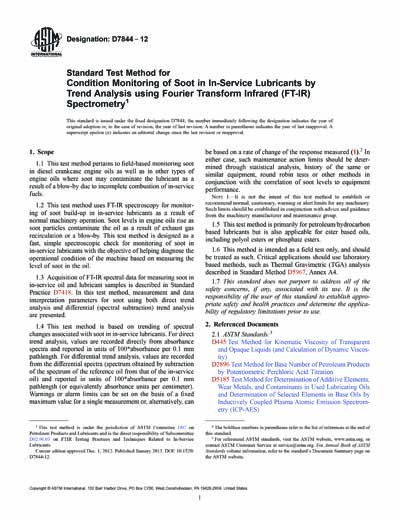Historical
ASTM D7844-12
Standard Test Method for Condition Monitoring of Soot in In-Service Lubricants by Trend Analysis using Fourier Transform Infrared (FT-IR) Spectrometry
1.1 This test method pertains to field-based monitoring soot in diesel crankcase engine oils as well as in other types of engine oils where soot may contaminate the lubricant as a result of a blow-by due to incomplete combustion of in-service fuels.
1.2 This test method uses FT-IR spectroscopy for monitoring of soot build-up in in-service lubricants as a result of normal machinery operation. Soot levels in engine oils rise as soot particles contaminate the oil as a result of exhaust gas recirculation or a blow-by. This test method is designed as a fast, simple spectroscopic check for monitoring of soot in in-service lubricants with the objective of helping diagnose the operational condition of the machine based on measuring the level of soot in the oil.
1.3 Acquisition of FT-IR spectral data for measuring soot in in-service oil and lubricant samples is described in Standard Practice D7418. In this test method, measurement and data interpretation parameters for soot using both direct trend analysis and differential (spectral subtraction) trend analysis are presented.
1.4 This test method is based on trending of spectral changes associated with soot in in-service lubricants. For direct trend analysis, values are recorded directly from absorbance spectra and reported in units of 100*absorbance per 0.1 mm pathlength. For differential trend analysis, values are recorded from the differential spectra (spectrum obtained by subtraction of the spectrum of the reference oil from that of the in-service oil) and reported in units of 100*absorbance per 0.1 mm pathlength (or equivalently absorbance units per centimeter). Warnings or alarm limits can be set on the basis of a fixed maximum value for a single measurement or, alternatively, can be based on a rate of change of the response measured (1).2 In either case, such maintenance action limits should be determined through statistical analysis, history of the same or similar equipment, round robin tests or other methods in conjunction with the correlation of soot levels to equipment performance.
Content Provider
ASTM International [astm]






